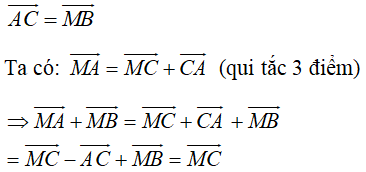Hãy nhập câu hỏi của bạn vào đây, nếu là tài khoản VIP, bạn sẽ được ưu tiên trả lời.

Với \(k\ne1\) và điểm O bất kì, ta có:
\(\overrightarrow{MA}=k\overrightarrow{MB}\) \(\Leftrightarrow\overrightarrow{OA}-\overrightarrow{OM}=k\left(\overrightarrow{OB}-\overrightarrow{OM}\right)\)
\(\Leftrightarrow\overrightarrow{OA}-k\overrightarrow{OB}=\left(1-k\right)\overrightarrow{OM}\)
\(\Leftrightarrow\overrightarrow{OM}=\frac{\overrightarrow{OA}-k\overrightarrow{OB}}{1-k}\) (đpcm)

a) \(\overrightarrow {MA} + \overrightarrow {MB} = \overrightarrow {MA} + \overrightarrow {AM} = \overrightarrow {MM} = \overrightarrow 0 \) (vì vectơ \(\overrightarrow {MB} = - \overrightarrow {MA} = \overrightarrow {AM} .\))
b) Xét hình bình hành BGCD ta có: \(\overrightarrow {GB} + \overrightarrow {GC} = \overrightarrow {GD} \)
\( \Rightarrow \overrightarrow {GA} + \overrightarrow {GB} + \overrightarrow {GC} = \overrightarrow {GA} + \overrightarrow {GD} = \overrightarrow {DG} + \overrightarrow {GD} = \overrightarrow {{\rm{DD}}} = \overrightarrow 0 \)
(vì \(\overrightarrow {GA} = - \overrightarrow {GD} = \overrightarrow {DG} \))

\(\left|2\overrightarrow{MA}+\overrightarrow{MB}\right|=\left|\overrightarrow{MA}+2\overrightarrow{MB}\right|\)
\(\Leftrightarrow4MA^2+MB^2+4\overrightarrow{MA}.\overrightarrow{MB}=MA^2+4MB^2+4\overrightarrow{MA}.\overrightarrow{MB}\)
\(\Leftrightarrow MA^2=MB^2\)
\(\Leftrightarrow MA=MB\)
Vậy tập hợp M là trung trực AB

Có vẻ không đúng.
Giả sử \(\overrightarrow{AB}+\overrightarrow{MB}+\overrightarrow{MA}=\overrightarrow{0}\)
\(\Leftrightarrow\overrightarrow{MB}+\left(\overrightarrow{MA}+\overrightarrow{AB}\right)=\overrightarrow{0}\)
\(\Leftrightarrow\overrightarrow{MB}+\overrightarrow{MB}=\overrightarrow{0}\)
\(\Leftrightarrow2\overrightarrow{MB}=\overrightarrow{0}\)
\(\Leftrightarrow M\equiv B\) (Vô lí)

a/ \(\overrightarrow{AC}=3\overrightarrow{AM};\overrightarrow{BN}=\frac{1}{2}\overrightarrow{BC}\)
\(\overrightarrow{MN}=\overrightarrow{MA}+\overrightarrow{AB}+\overrightarrow{BN}=\frac{1}{3}\overrightarrow{CA}+\overrightarrow{AB}+\frac{1}{2}\overrightarrow{BC}\)
\(=\frac{1}{3}\overrightarrow{CB}+\frac{1}{3}\overrightarrow{CD}+\overrightarrow{DC}+\frac{1}{2}\overrightarrow{BC}=\frac{2}{3}\overrightarrow{DC}+\frac{1}{6}\overrightarrow{BC}=\frac{2}{3}\overrightarrow{AB}+\frac{1}{6}\overrightarrow{BA}+\frac{1}{6}\overrightarrow{AC}=\frac{1}{2}\overrightarrow{AB}+\frac{1}{6}\overrightarrow{AC}\)
Hmm, MN làm sao vuông góc vs BC đc. Nó chỉ vuông góc khi M là TĐ của AC thôi, bởi N là trung điểm của BC rồi mà, hại não :((
2/\(\overrightarrow{BK}=\frac{4}{13}\overrightarrow{BA}\Rightarrow\overrightarrow{BC}+\overrightarrow{CK}=\frac{4}{13}\overrightarrow{BC}+\frac{4}{13}\overrightarrow{CA}\)
\(\Leftrightarrow\overrightarrow{CK}=\frac{9}{13}\overrightarrow{CB}+\frac{4}{13}\overrightarrow{CA}\)
\(\overrightarrow{GB}+\overrightarrow{GM}+\overrightarrow{GN}=\overrightarrow{0}\)
\(\Leftrightarrow\overrightarrow{GC}+\overrightarrow{CB}+\overrightarrow{GC}+\overrightarrow{CM}+\overrightarrow{GC}+\overrightarrow{CN}=\overrightarrow{0}\)
\(\Leftrightarrow3\overrightarrow{GC}+\overrightarrow{CB}+\overrightarrow{CN}+\overrightarrow{NM}+\overrightarrow{CN}=\overrightarrow{0}\)
\(\Leftrightarrow3\overrightarrow{GC}+\overrightarrow{CB}+2\overrightarrow{CN}+\frac{1}{2}\overrightarrow{BA}+\frac{1}{6}\overrightarrow{CA}=\overrightarrow{0}\)
Ta có : \(\overrightarrow{CN}=\frac{1}{2}\overrightarrow{CB}\Rightarrow3\overrightarrow{GC}+\overrightarrow{CB}+\overrightarrow{CB}+\frac{1}{2}\overrightarrow{BA}+\frac{1}{6}\overrightarrow{CA}=\overrightarrow{0}\)
\(\Leftrightarrow\overrightarrow{CG}=\frac{2}{3}\overrightarrow{CB}+\frac{1}{6}\overrightarrow{BA}+\frac{1}{18}\overrightarrow{CA}\)
\(\Leftrightarrow\overrightarrow{CG}=\frac{2}{3}\overrightarrow{CB}+\frac{1}{6}\overrightarrow{BC}+\frac{1}{6}\overrightarrow{CA}+\frac{1}{18}\overrightarrow{CA}\)
\(=\frac{1}{2}\overrightarrow{CB}+\frac{2}{9}\overrightarrow{CA}\)
Có \(\overrightarrow{CK}=\frac{18}{13}\overrightarrow{CG}\Rightarrow\) C,G,K thẳng hàng

